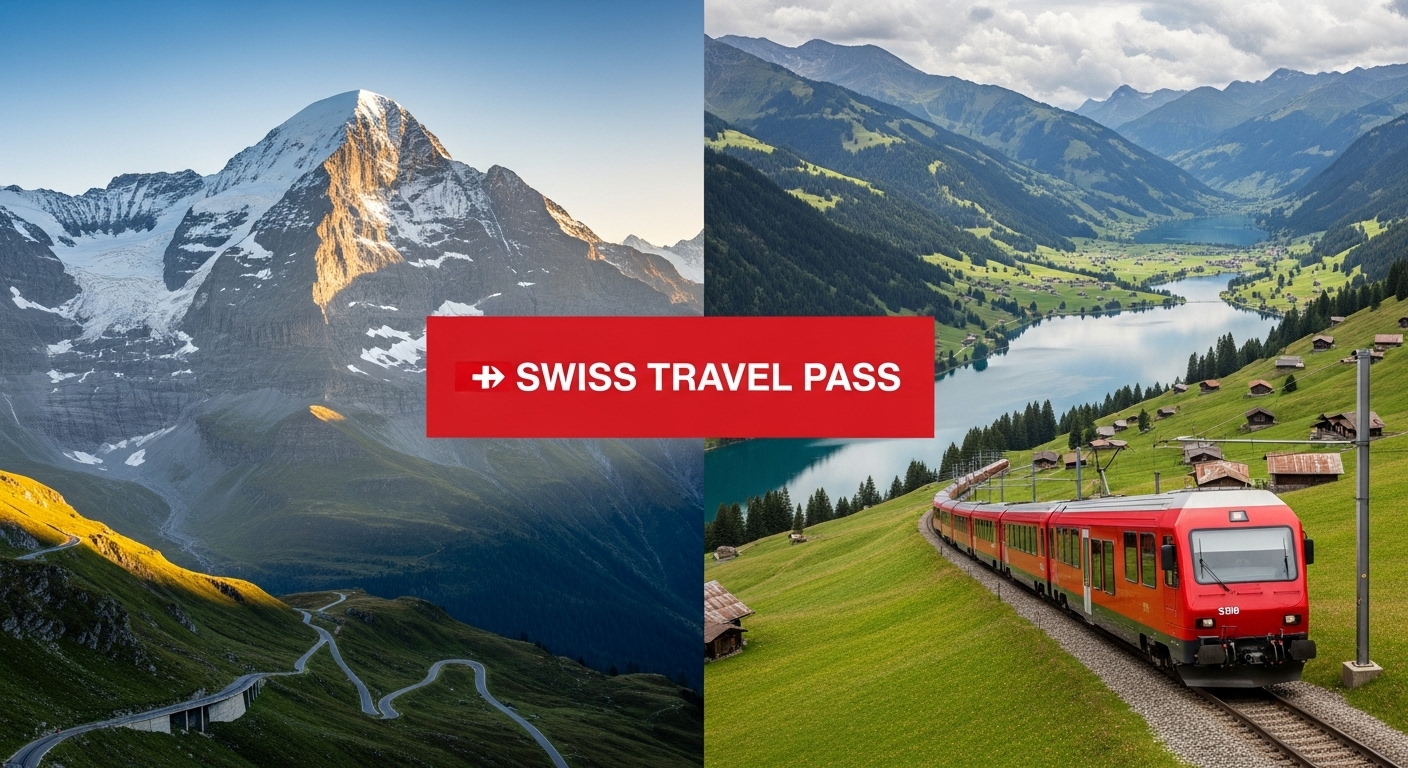# Eurail Pass Backpacking Europe Cost: A 2024 Savings Guide
Dreaming of hopping from the canals of Amsterdam to the Colosseum in Rome, all with the romantic rhythm of a train? The Eurail Pass has long been the quintessential ticket to this backpacker fantasy. But in a world of budget airlines and advance-fare discounts, a critical question looms over every itinerary: will a Eurail Pass actually deliver on its promise of backpacking Europe cost savings, or will it drain your travel fund? This guide cuts through the marketing to give you the real numbers, a step-by-step calculation method, and the final verdict on whether the legendary pass is right for your 2024 adventure.
Table of Contents
- Understanding the Eurail Pass Basics
- The Hidden Cost: Mandatory Reservation Fees
- How to Calculate Your Eurail Pass Savings in 4 Steps
- Advanced Strategy: The Hybrid “Mix-and-Match” Approach
- Eurail Pass vs Point-to-Point Tickets Comparison
- Is a Eurail Pass Worth It for Backpacking? The Verdict
- Smart Budget Alternatives & Hidden Savings
- Conclusion: Do the Math for Maximum Savings
Understanding the Eurail Pass Basics
Before we crunch the numbers, let’s cover what a Eurail Pass is. It’s a single train pass that grants you access to most rail networks across 33 European countries. There are two main types, each with its own structure for travel day optimization:
- Global Pass: The most popular option, offering travel across all 33 participating countries. This pass comes in two flavors:
- Flexi Pass: Provides a specific number of travel days to be used within a set period (e.g., 7 days within 1 month). This is ideal for backpackers who plan to stay in cities for several days between train journeys.
- Consecutive Pass: Offers unlimited travel for a continuous period (e.g., 15 straight days). This is best for a whirlwind tour where you are on the move almost every single day.
- One Country Pass: Best if you plan to explore a single country in depth, like Italy or Spain.
The core appeal is flexibility—the freedom to show up at a station and hop on a train. However, as we’ll see, this freedom isn’t always free.

A backpacker planning their Eurail Pass backpacking Europe cost savings on a train journey
The Hidden Cost: Mandatory Reservation Fees
This is the single most important factor that determines your Eurail Pass backpacking Europe cost savings. While your pass covers the “ticket,” it does not always cover your seat. Many trains, especially high-speed (like TGV in France, Frecciarossa in Italy), overnight, and popular international routes, require a mandatory seat reservation for a fee.
These fees are not just averages; they are precise, country- and train-specific costs that can range from €4 to over €30 per journey. Suddenly, your “free” travel day costs you extra.
A look at specific, high-demand route reservation fees:
- France (High-Speed TGV): €10 – €20+ per domestic leg.
- Italy (High-Speed Frecciarossa): ~€13 per leg.
- Spain (High-Speed AVE): ~€10 per leg.
- International Routes (e.g., Eurostar from Paris to London): Can be €30-€40+ and have very limited availability for pass holders, often selling out weeks in advance.
These fees can quickly add up, turning a supposedly good deal into a costly mistake. Always factor in the precise fees for your intended routes. For a detailed breakdown, it’s crucial to check the most current information by understanding mandatory Eurail seat reservation fees directly on their official portal.
How to Calculate Your Eurail Pass Savings in 4 Steps
Don’t guess—calculate! This simple process will give you a definitive answer on whether a pass is worth it for your specific trip.
- Sketch Your Dream Itinerary: List the exact train journeys you plan to take. For example: Paris to Amsterdam, Amsterdam to Berlin, Berlin to Prague. Your `Eurail Pass itinerary planning` is the foundation of your budget. This is also the stage where you should start looking at secure hostel bookings for European backpacking trip to get a full picture of your daily costs.
- Price Point-to-Point Tickets: Go to the websites of the national rail operators (like Germany’s Deutsche Bahn or Italy’s Trenitalia) and look up the price for each individual leg of your journey. Important: Factor in fare fluctuations. Point-to-point tickets operate like airline fares; they are cheapest when booked 2-3 months in advance and can be ruinously expensive for last-minute travel. This advance-purchase price is your baseline cost. To get started, try researching individual train ticket prices on official carrier sites, which has one of the most comprehensive search engines for European rail.
- Add Up Your Precise Reservation Fees: Using the Eurail site or app, find the mandatory reservation fee for each of your planned high-speed or overnight journeys. Do not use averages. Total these up.
4. Do the Final Math:
* Cost A: Total price of all your point-to-point tickets (booked in advance).
* Cost B: Price of the Eurail Pass that fits your trip + Total of your mandatory reservation fees.
Compare Cost A and Cost B. The lower number is your winner.
Expert’s Take
“The true value of a Eurail Pass often lies in its flexibility for spontaneous, long-distance travel, not just the raw cost savings on a pre-planned route.”
Advanced Strategy: The Hybrid “Mix-and-Match” Approach
A Eurail Pass doesn’t have to be an all-or-nothing commitment. The smartest backpackers often use a hybrid strategy, combining a pass with other forms of transport to maximize savings. This “mix-and-match” strategy involves identifying when to use a valuable Eurail travel day versus buying a separate ticket.
Here’s how it works:
- Use the Eurail Pass for: High-value journeys. This includes long-distance trips, cross-border travel in countries with low reservation fees (like Germany, Austria, Switzerland), and any spontaneous trips you decide to take. These are the legs where last-minute point-to-point tickets would be most expensive.
- Buy Point-to-Point Tickets for: Low-value or high-fee journeys. If a short trip between two cities costs only €20, it’s not worth using a €50+ travel day from your Flexi Pass. Similarly, for a route with a €30 reservation fee, it might be cheaper to buy an advance point-to-point ticket instead of using the pass and paying the fee.
- Use Buses or Flights for: Specific routes. For non-scenic but long-distance routes (e.g., Warsaw to Budapest), a budget flight can save an entire day. For shorter regional trips (e.g., Florence to Siena), a cheap bus is often more direct and economical.
This approach requires more planning but gives you the best of both worlds: the cost savings of advance booking and the flexibility of a pass where it counts most.
Eurail Pass vs Point-to-Point Tickets Comparison
To simplify your decision, let’s break down the core differences. Your `backpacking Europe train travel budget` will be heavily influenced by which path you choose.
Best For
- Eurail Global Pass: Spontaneous travelers, multi-country trips with long-distance legs, and those who value flexibility over rock-bottom prices. Ideal for travel in countries with low/no reservation fees like Germany, Switzerland, and Austria.
- Point-to-Point Tickets: Budget-conscious travelers, those with a fixed itinerary planned far in advance, and trips focused on one or two countries, especially where budget airlines or buses are plentiful.
Cost Structure
- Eurail Global Pass: High upfront cost for the pass, plus precise, non-negotiable seat reservation fees for each high-speed or overnight journey.
- Point-to-Point Tickets: Pay-as-you-go. Can be extremely cheap if booked months in advance, but very expensive for last-minute, long-distance journeys due to dynamic pricing.
Flexibility
- Eurail Global Pass: Extremely high. You can change your plans on a whim and hop on most regional trains without a second thought. This is its biggest selling point.
- Point-to-Point Tickets: Very low for the cheapest advance-purchase tickets, which are often non-refundable and non-changeable. Flexible (full-fare) tickets are available but are usually much more expensive.
Planning Effort
- Eurail Global Pass: Moderate. You still need to research and book mandatory reservations for many key routes, which can sometimes sell out for pass holders.
- Point-to-Point Tickets: High upfront. Requires diligent research to find and book the cheapest fares for each leg of your journey well in advance to maximize savings.

Comparison of the stress of point-to-point tickets vs the flexibility of Eurail Pass for backpacking Europe
Is a Eurail Pass Worth It for Backpacking? The Verdict
So, what’s the final answer to the `is Eurail Pass worth it for backpacking` question? It depends entirely on your travel style.
A Eurail Pass is likely worth it if:
- You crave flexibility: You want the freedom to change your plans last minute without buying an expensive new ticket.
- Your trip is long and covers multiple countries: The more long-distance, cross-border journeys you take, the more value you extract.
- You’re traveling primarily in countries with low reservation fees: Think Germany, Switzerland, Austria, Belgium, and the Netherlands.
- You are under 27: The Youth Discount offers significant savings on the pass price.
A Eurail Pass is likely NOT worth it if:
- You are on a strict budget: Booking advance point-to-point tickets or using a mix-and-match strategy is almost always cheaper.
- Your itinerary is fixed: If you know exactly where you’re going and when, you can capitalize on cheap advance fares.
- You are traveling mostly in one or two regions: Especially in Eastern Europe or the Balkans, where individual tickets are already very inexpensive.
- Your trip involves many high-speed trains: Journeys in France, Spain, and Italy can rack up reservation fees that negate your savings. When planning your multi-country Schengen Area itinerary, be sure to map out which countries require the most expensive reservations.
Smart Budget Alternatives & Hidden Savings
Train travel is classic, but incorporating other options is key to a truly optimized budget. Consider these “hidden savings” opportunities when building your `backpacking Europe train travel budget`.
- Budget Buses: Companies like FlixBus and BlaBlaCar Bus offer an extensive network across Europe for a fraction of the price of trains. The trade-off is longer travel times, but the savings can be massive for shorter legs.
- Budget Airlines: For longer distances (e.g., Lisbon to Budapest), airlines like Ryanair and easyJet can be faster and even cheaper than the train. Learning how to find cheap last minute flights in Europe is a key skill, especially if you book in advance and travel light. Just watch out for baggage fees!
- Regional Train Passes & Discount Cards: Many countries offer their own regional day passes (like Germany’s Länder-Tickets) or weekend deals that are a great value for exploring a specific area. Additionally, some national rail companies offer youth or senior discount cards that provide significant savings on point-to-point tickets within that country for a small annual fee. It’s also wise to research and stay informed about understanding your rail passenger rights in the EU, which can be helpful regardless of how you book.
Conclusion: Do the Math for Maximum Savings
The key to maximizing your Eurail Pass backpacking Europe cost savings isn’t a secret trick—it’s doing the homework. By meticulously planning your route, comparing advance point-to-point fares, and honestly accounting for every specific reservation fee, you can make an informed decision. Don’t forget the power of the hybrid approach: combine a Eurail Pass for its flexibility on expensive routes with cheap, pre-booked tickets and buses for shorter or high-fee journeys. For the spontaneous adventurer, the pass remains a valuable tool. For the meticulous planner, a smart mix-and-match strategy will always win the day.
Ready to explore more ways to save on your European adventure? Check out our other in-depth Rail Passes guides for more expert tips and comparisons.



